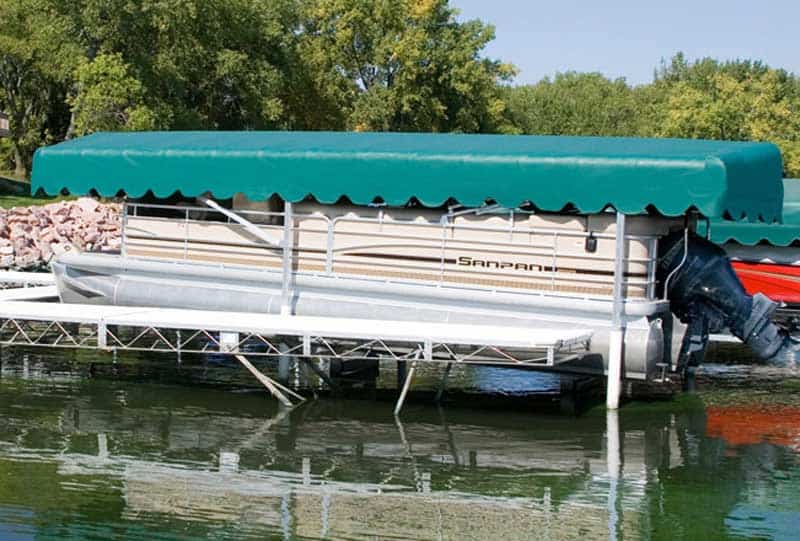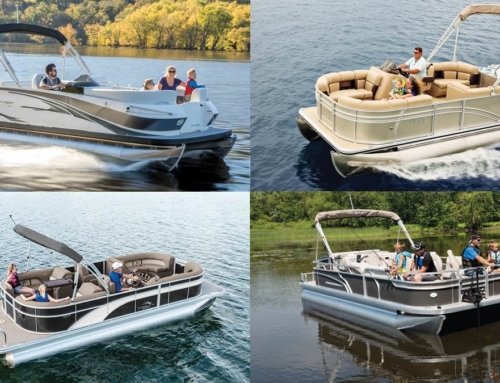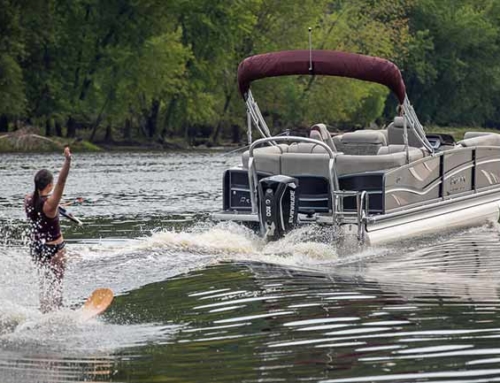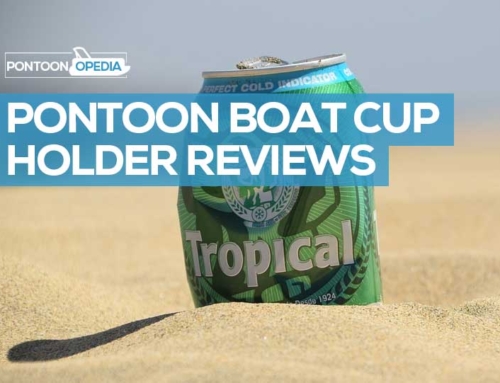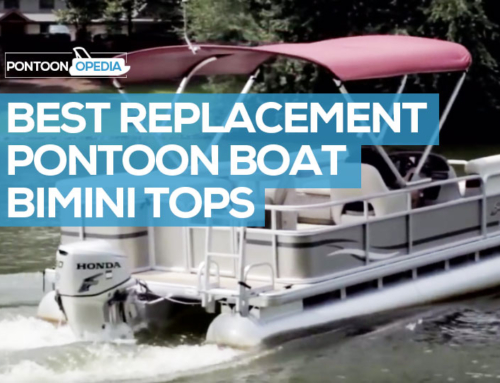After choosing your pontoon boat, choosing a lift is probably going to be the most complex and challenging aspect to your boat ownership.
Pontoon boat lifts can be complicated, there are various styles, and the one you choose will also depend on where your boat is, how large it is, and what height you will need – for example, will you need a pontoon lift that can accommodate the height of your Bimini?
In this guide, you will find out about the different types of pontoon lifts you can buy, the prices, and also some recommendations on who I believe to be the top 5 manufacturers based on the reviews they all have online. Those review segments are lower down the page.
But before you get into choosing what brand and model, you’ve got a little bit of work to do in better understanding what type of pontoon lift is going to be right for you.
Below contains an overview of the different pontoon boat lift types, including the pros and cons to each, and why they could be a good fit for you when protecting your boat from the water, or when you need to transport it.
Things to Know About Pontoon Boat Lifts
Before you buy, or even consider buying a lift, here are 4 essential things that you need to know about these pieces of kit.
Location and Structural Strength
Location is very important when buying your boat lift. For example, water on a main channel requires a stronger and more durable lift than one used in a shallow inlet.
Your pontoon lift should be suitable to the conditions you dock your boat in. You could be able to get away with paying less if your boat is on a very placid lake.
Water Depth
As I will come onto later in this guide, different pontoon lifts suit different water depths. Shallower water can be hard to get out of without the support of a lift specially designed for those conditions as they can add up to an extra foot in lift height.
Nothing is more frustrating than not being able to get your boat off the lift because the water is too shallow on your chosen day to get out on the water.
Slip Width
As obvious as it might sound, you need to be certain that your lift if the correct width if being used in a dock slip.
Investing in the wrong sized boat lift can lead to you having to time consuming and expensive changes to structure and beams.
Weight and Capacity
The size of your pontoon boat is what will determine how the large the lift is.
Also, be aware of weight limits, including dry weight and when fully loaded, to make sure that any pontoon lift you choose can has that load capacity.
Table of Contents
Pontoon Lift Styles & Different Cradle Types
1. Freestanding Pontoon Lifts
Firstly, let’s take a look at what tend to be the more common lift types, which are the freestanding types. These aren’t fixed to the docking area, but instead stand in the water and can’t be moved once set down.
They are very heavy and come in two different types; cantilever and vertical.
Cantilever Boat Lifts
Best for: Shallow water or sandy bottoms
Cantilever boat lifts are best used where there is very little water depth fluctuation. They only make use of one cable and don’t have as many moving parts as vertical lifts, making them easier to maintain, and cheaper.
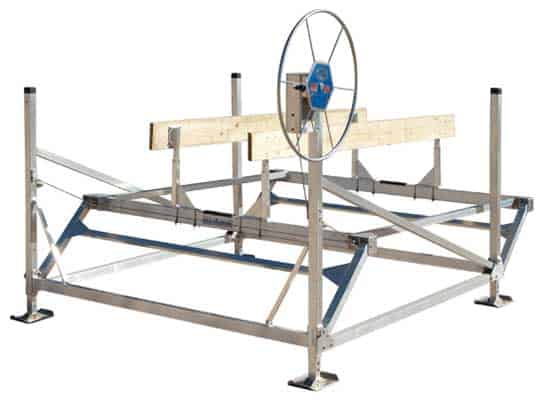
An example of a cantilever lift from the Pier Pleasure manufacturer.
They come with a full-length cradle, meaning they offer support down the entire length of your boat’s pontoon tubes, giving you protection from stress and damage.
Vertical Boat Lifts
Best for: Water with fluctuating depths and uneven bottoms
Vertical lifts use mainframe spreader beams and adjustable legs, making them ideal for bottoms which might be uneven, and where water depth can fluctuate.

ShoreMaster’s Vertical lift was created to operate in shallow or deep water levels and offers premium protection.
Where maximum clearance is needed, vertical boat lifts trump cantilever models, letting you keep your pontoon boat high and dry without having to constantly make adjustments.
The mainframe design works like a box keeping everything sturdy and protected against the wind and buffering from waves.
You can buy manual operated models, or hydraulic ones which are operated via a remote control. Expect to pay more for the hydraulic models though!
Show example and image.
2. Floating Boat Lifts
Floating boat lifts, just like the freestanding models, come in two distinct types; air or water displacement lifts, and hydraulic lifts.
They tend to be quieter than standard pontoon boat lifts, and work very well in saltwater areas as the steel parts are kept above water whilst in operation.
They are also relatively simple to install in a marina or dock, as no piling or construction will be required, with no limitations on marina configuration.
Air & Water Displacement Lifts
Best for: Shallow water, even up to 4 feet deep
Air or water is blown into a pair of underwater inflatable pontoons which will then raise the lift up as they become buoyant. And then to lower back into the water, the air or water pressure is reduced down.
You don’t need much water depth to use these pontoon lifts, they are reasonably cheap and versatile, but don’t offer the stability and smoothness that other types of boat lifts do.
Show example and image.
Hydraulic Floating Lifts
Best for: Extremely shallow water, even up to 12 inches deep
Hydraulic floating lifts can be mounted to fixed or floating docks and can operate in just 12 inches of water.
They are more expensive than their air and water displacement counterparts, but some models can be used with solar power, doing away with electrics completely.
Show example and image.
Pontoon Boat Lift Reviews & What’s the Best
Choosing the right lift for your boat is just as important as the day you actually chose your pontoon. With various brands and models on the market, it’s not always that easy to figure out which is the best to buy.
Below you can read some very quick pontoon boat lift reviews of the various manufacturers that are selling today, which I hope will give you a little bit more guidance on what you need to buy.
I have only listed the top 5 manufacturers here, based on the reviews that I have read online.
Before you do decide to buy, understand what features you are going to need including weight limits, the construction, on what type of lifting system is in use.
ShoreMaster
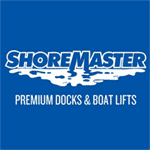
This is without doubt one of the best pontoon boat lift manufacturers on the market today. They range cantilever, vertical, and hydraulic models and have a fantastic online reputation and excellent reviews.
Established in 1972, they are a Minnesota-based company and manufacture superb lifts that are designed to work with the demands on modern pontoon boats.
Their models come with pontoon specific accessories, longer and wider bases, and a massive 15-year guarantee, which shows just how much faith they have in their product.
They can lift and hold pontoon boats weighing between 4,000 to 7,000 pounds, so should accommodate even the largest of vessels.
ShoreStation
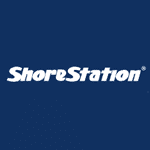
ShoreStation have been around since 1959 and sell pontoon lifts that can carry between 1,500 and 10,000 pounds, giving you a wide range of options depending on the size of your pontoon boat.
With models including both automatic and manual operation, each lift comes with standard features including extension legs, adjustable legs, wireless operation, and even some deeper water models.
They offer three different styles; hydraulic, power winch, and manual winch.
Pier Pleasure

As one of the newer manufacturers, and by that, I mean 1974, they are very well respected in the boating world for their cantilever and vertical lifts which work well in shallower waters.
If you thought a 15-year guarantee was good, then these guys go even better with a huge 20-year warranty on all their aluminum lifts. I think that’s why when it comes to the pontoon boat lift reviews, they will so often come out on top.
Their cantilever models are able to hold a 9 and a half foot beam and up to 2,400 pounds in weight. The vertical pontoon lifts go larger, with a maximum payload of 5,000 pounds.
Hewitt Manufacturing
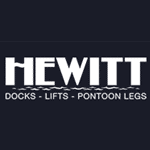
Like so much of the pontoon boat industry, this manufacturer is also located in Minnesota, where it was established in 1971. They came about when Larry Hewitt decided they wanted to build their own lift, and little did they know what that would lead to today.
Since then, Hewitt has gone on to be considered a leading producer of pontoon lifts, with great reviews to match.
They sell a wide range of lifts, with weight capacities ranging from 2,000 to 3,000 pounds all made in their 22 square foot manufacturing plant.
Porta-Dock
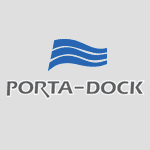
One of the oldest manufacturers in this list of reviews, is Porta-Dock, who have been building quality marine equipment since 1966.
Porta-Dock offer 15-year warranties on their pontoon lifts, which include cantilever, vertical, and shallow water models.
In terms of weight capacity, Porta-Dock lifts can hold anything between 2,200 to 5,000 pounds, with widths of up to 120-inch beams.
Which Manufacturer Should You Choose?
So, what is the best pontoon boat lift from that list of manufacturers?
I genuinely mean this when I say all of the ones listed below are a great choice, and I’ve only listed what I believe to be the best based on online research.
You will need to make your choice on the type you need, dimensions, and features. By comparing the pontoon boat lift brands above, you should be able to arrive at a final decision.
Average Pontoon Boat Lift Prices
Whilst researching all I could find out about pontoon boat lifts, I also took at how much they cost. You can see some of those example prices and costs in the table below which includes figures found in 2018.
| Lift Type | Dimensions | Price / Cost |
|---|---|---|
| Budgets Cantilever Lifts | 84 inches wide x 19 feet long | $1,555 |
| 96 inches wide x 21 foot feet long | $2,005 | |
| Budget Vertical Lifts | 114 inches wide x 23 foot feet long | $2,280 |
| 114 inches wide x 26 foot feet long | $3,197 | |
| 120 inches wide x 23 foot feet long | $3,290 | |
| 120 inches wide x 26 foot feet long | $3,940 | |
| Shoremaster Premium Lifts | Various sizes | $6,000 to $12,000 |
For further details on how much pontoon lifts costs, please take a look at this further guide.
How to Convert a Boat Lift to a Pontoon Lift
The problem that many pontooners will face, particularly if they have graduated from owner a v-shaped hull boat to a pontoon, is what to do with their old boat lift.
Boat lifts for typical boats are not designed to accommodate for pontoons, and so many boat owners will look to see if they convert their existing lift to fit their new pontoon.
It’s a DIY project that many boat owners will feel comfortable in doing, but there can be risks attached. The risks are primarily associated to the weight distribution and making sure that the converted lift and take the pontoon’s weight and structure.
Whilst I do in no way claim to be a DIY expert, and I have zero experience in converting one, I have done some research which I think might help you decide whether this is something you will want to do.
You can read up more about what I found out about conversion projects elsewhere on Pontoonopedia.
You don’t have to make all the parts yourself. Companies such as ShoreStation actually sell conversion kits, with prices being around $1,300 dollars for everything that you need.
Pontoon Boat Cradles
It’s also worth mentioning pontoon boat cradles. Unlike boat lifts, cradles are bolted to a dock and can’t be moved or adjusted. They are very similar to the bunks that you see on a pontoon trailer.
There are two main types of cradle that pontooners might use to lift their boat;
- Center Lift Cradles: These are very good for lifting tritoons due to the strength, but they lift the boats flooring, so over time can cause damage to your boat.
- Bunk Style Cradles: These are more similar to the support systems in a boat trailer and are considered the most stable.
Recommended Accessories and Add-Ons for Pontoon Boat Lifts
After selecting the right pontoon boat lift for your needs, consider boat lift accessories and add-ons to enhance its functionality and convenience.
There are many accessories and add-ons that can help to protect your pontoon boat from the elements, make the lifting process easier, and make your boat lift more user-friendly.
Read below for a list of recommended accessories and add-ons for pontoon boat lifts.
Canopies
Canopies protect your boat by shielding it from the sun, rain, and other environmental factors.
A quality canopy will help preserve your boat’s aesthetics and essential components like upholstery, finish, and electronics. UV rays and weather conditions can sometimes damage these components, making canopies especially useful.
Look for a canopy that is made of durable, weather-resistant materials and is large enough to cover your whole boat.
Lift Motors
Lift motors automate the process of raising and lowering your pontoon boat. Motors make it easier and more convenient to use your boat lift, especially if you’re a new boat owner.
Choose from various kinds of lift motor options including electric and hydraulic. These can be operated using a switch, remote control, or even an app.
When deciding on a lift motor, consider things like maintenance requirements, ease of installation and the power source availability.
Remote Controls
Having a remote control for your boat lift will allow you to operate it from a distance. This provides added convenience and safety.
Remote controls are most useful for boat lifts with motors, which enable you to raise or lower your boat without having to manually operate your lift.
There are many types of remote controls including smartphone apps and handheld devices.
Solar Panels
Solar panels can provide an environmentally-friendly and less expensive power source for your boat lift motor and other electrical components.
Installing solar panels on your boat lift can help reduce energy costs by sustainably harnessing the sun’s energy for power.
Wheel Kits
Wheel kits make it less complicated to move and reposition your pontoon boat lift. They especially come in handy when you need to adjust its location because of fluctuating water levels or seasonal weather changes.
In the long run, wheel kits save you time and energy when relocating your boat lift. They ensure your lift stays in the optimal position for your needs.
Conclusion
Using a boat lift is far easier than launching a pontoon from a trailer, and also helps you to protect your hard-earned investment from all the damage that can occur from sitting constantly in water.
They are very convenient, but you will have to pay a premium price for that convenience, particularly with the higher end models from companies such as ShoreStation and ShoreMaster.
I don’t believe that is really a product you can simply research online and then buy, as there are so many variables at play.
This guide is intended to be a primer, so when you go to a local dealer you are going to be a little bit informed than you otherwise might have been.
Good luck!

